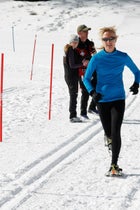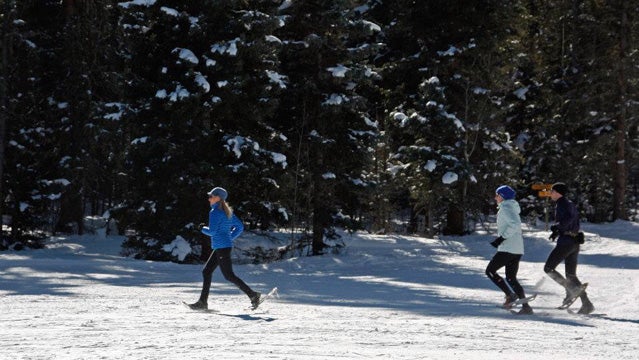On the beach, of course. And because Florida has 1,260 miles of , you really have no excuses.
 Florida resident Ceal Muldoon sprints to the finish at the 2012 Low O2 Challenge in Red, River, New Mexico. The 10K race was a qualifier for the national championships.
Florida resident Ceal Muldoon sprints to the finish at the 2012 Low O2 Challenge in Red, River, New Mexico. The 10K race was a qualifier for the national championships.Sure, you might look a little strange wearing snowshoes in the sand, but you’ll reap strength and endurance benefits that you won’t achieve by just running on the road. “Snowshoe running and sand running utilize a lot more effort than a regular run,” says Ceal Muldoon, a Cocoa Beach, Florida, resident who has qualified for the U.S. snowshoe national championships six times. “The effort of a three-mile run feels like it is doubled when run on the sand or snow, so it is advisable to build up your endurance slowly.”
Muldoon, who has run for both the University of Florida and Adidas, suggests walking or jogging slowly to get used to the feel of snowshoes—and to the extra effort required for each step—while maintaining your normal running gait and form. “For example, you can start with a 30-minute run, but run two minutes, walk one minute, and repeat throughout the duration of the 30 minutes,” she says. “When you are comfortable with this amount of time (after three or four runs) move up to three-minute efforts with a one-minute rest, and so on, until you can run the whole 30 minutes without stopping.”
This type of sand/snowshoe running should be incorporated into training at least two to three days per week and, as you improve, can incorporate tempo runs, intervals, and even long runs. “Because most snowshoe races include hills, hill training must be done on ‘Florida hills’ such as causeway bridges or parking garages” sans snowshoes, Muldoon advises.
Sounds easy enough, right? For sure, but keep the following hazards in mind when you’re running: catching the tip of your snowshoe in the sand and face planting, getting seaweed stuck to the bottom of your snowshoes, and tripping on beach vines. Also, sand is more abrasive than snow (obviously) and can wear down snowshoes quickly. “I use an older pair to train in and keep a pair that is exclusively used for races,” says Muldoon, who placed fourth at the 2012 New Mexico .
The high school track coach also advises using gaiters for protection. “Just like with running in snow, it is imperative that you use gaiters while training on the sand or your four-ounce minimalist shoes will turn into four-pound sand bags,” she says. “I like the INOV8 gaiter socks, since they are effortless to put on, but they keep any sand from entering your shoes.”
THE BOTTOM LINE: Don’t let living hundreds of miles from snow deter you from snowshoe running. “Just find a nice stretch of beach to train for your goal race,” Muldoon says. “To avoid the heat, start your run early in the morning—and don’t forget your sunscreen.”


